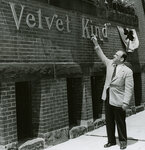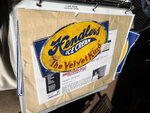Clear, 85°
Wind: mph,


This story is in honor of National Ice Cream Month.
A Severna Park road bears the name of a man who revolutionized the ice cream industry.
The son of a dairy operator, Lionel Manuel Hendler was born in 1885. He worked for his father, Isaac, and threw out about half the milk produced each day. Before long, the 19-year-old had an idea: instead of wasting milk, he could use it to make ice cream.
In “Stories of Severna Park with Scott Jay,” produced by Charles Germain of Chesapeake Clear Videos and Films, Jay recalled how Hendler started a business. Hendler’s work began in the basement of Louis Miller’s home before Hendler took full control of the company and expanded to a large factory at 1100 East Baltimore Street by the time he was 24.
“He then went to all the druggists that were on the corner drug stores and said to them, ‘I will be happy to put a soda foundation in your drug store as long as when people are waiting for their prescription that you would sell them my ice cream,’” Jay said. “And so that’s what he did.”
Marylanders began to recognize Hendler’s blue and yellow signs promoting its ice cream as “the velvet kind,” its “brick” packaging size, and advertisements featuring the cherubic Kewpie character created by artist Rose O’Neill.
Hendler Creamery Company continued expanding until it had 120 delivery trucks supplying ice cream to more than 400 stores.
The business offered vanilla, chocolate and strawberry, along with many other flavors. Peach was a summertime staple. Peppermint, licorice and spiced apple were among the other offerings.
Gilbert Sandler’s book “Jewish Baltimore: A Family Album,” published in 2000, got the scoop on other treats. One of Hendler’s four children, Albert, discussed the flavors, including one that gave customers something to buzz about.
“But the best flavor was tomato aspic, which we made as a specialty for the Southern Hotel,” Albert mentioned in the book. “It was served as a staple with the main course at dinner. Eggnog ice cream was one of our bestsellers. It was flavored with pure rum, which we put in bonded warehouses for three years. To my knowledge, we were the only ice cream company in the nation to have a liquor or rectifier’s license for the blending of whiskey for other than drinking purposes.”
That was not Hendler’s only innovative idea. He and his son had 32 patents related to ice-cream making.
According to the Association of Ice Cream Manufacturers, Hendler was the first to install the fast frozen method, allowing ice cream to be frozen with a texture comparable to liquid cream instead of a consistency of ice crystals that most products of the era had. Ice cream had to be hand-packed into cans until Hendler designed an automatic ice cream can filling machine.
In the early 20th century, companies made deliveries by horse-drawn carriage, mostly to nearby neighborhoods that could enjoy the treats before they melted. Hendler Creamery started using an all-motor fleet of refrigerated trucks to cover a larger delivery area.
Hendler established himself as a shrewd businessman and a community advocate who served on the board of directors for the Red Cross, Boy Scouts and other organizations. Every Christmas season, Hendler’s also donated ice cream to orphanages and hospital wards.
In the 1920s, he also became involved in the growth of Severna Park. Because he was Jewish, Hendler was barred from playing golf at facilities in Baltimore, where he lived and worked.
“So he went to Oscar Hatton, who was the developer of Severna Park, and there was a nine-hole golf course there,” Jay said. “He volunteered to put in another nine holes and to build a clubhouse.”
Located in the Harlequin community, the clubhouse had a card room upstairs, a bar, a lady’s room and a men’s room, along with a kitchen. Hendler invited guests for swimming, golfing, singalongs, and crab feasts while making his guests feel at home.
“A lot of the women or the druggist’s wives didn’t want to come down to the county and have to ride on the train, so Mr. Hendler tried to make this look like the city as much as he could,” Jay said of the clubhouse area. “So he put in a brick sidewalk and he had cobblestone streets here for them, along with gas lights that were put in.”
Following the parties, the guests walked to Robinson Road to hail the train back to Baltimore.
As for his business, it remained locally owned until it was bought by Borden’s in 1929. The Hendler family continued to manage the company until the 1960s. Hendler died in 1961 after a short illness.
Although Hendler’s is no longer active, the family left a sweet legacy behind.
Comments
No comments on this item Please log in to comment by clicking here